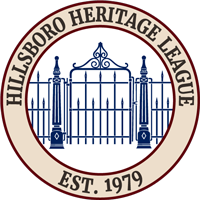Patterson’s Institute Setting a High Standard for Education in Hillsboro 1885-1901

Patterson's Institute Setting a High Standard for Education in Hillsboro 1885-1901
Glimpse of the Past, The Hillsboro Reporter, Thursday, September 3, 2015, Page 8B
Education was important to the founders of Hill County and Hillsboro in 1853, witnessed by the fact that among the first log structures to follow the courthouse was a small, simple schoolhouse that today is the site of the John W. Erwin Hill County Courthouse Annex at 200 East Franklin Street in Hillsboro. Early schools in Hillsboro were "public" but not free, and Hillsboro's bond election in 1885 provided a school for African-American children that came to be known as Peabody School.
Central School was erected with funds from a bond issue by the City of Hillsboro in 1885, and this impressive brick building was erected at 200 East Franklin Street. The May 26, 1887 Hillsboro Expositor reported that the City Council re-elected Professor J. A. Clark as superintendent and renewed contracts for Misses Sallie Dixon, Ela Reid, Portia Reid, and Ada Terrill.
Early schools in Hillsboro and Hill County, however, were more frequently operated by the Masonic Lodge, churches, or private organizations. There was considerable competition among schools in the early days of the county, and it was not until after 1901 that the free public schools became dominant in Hillsboro. By 1906 enrollment in Central School in Hillsboro had expanded and led to erection of a new high school at 310 East Walnut.
In 1885 Rev. Warren A. Patterson came to Hillsboro to pastor the Cumberland Presbyterian Church, where a new frame building was erected in 1887 on the lot deeded to the church in 1859 by W. R. Nunn, early settler from Tennessee. The church was erected on the site where the Citizens National Bank is presently located at the SE corner of Elm and Church streets.
Kentucky native W. A. Patterson married Frances Didiot in Tennessee in June, 1865. Locating in Hillsboro in 1885 with the Pattersons were her parents, Professor Joseph Didiot and brother and sister-in-law, Joseph G. and Margaret Lovejoy Didiot. Margaret's parents also came to Hillsboro and the Lovejoys resided at 511 East Franklin in 1900.
Patterson's dream of establishing a quality educational institution was realized when he purchased two lots on Corsicana Street and erected a two-story frame classroom building at 308 Corsicana Street and a dormitory at 304 Corsicana. Patterson's Institute was a co-education school and provided classes from primary grades to college level. Joseph Didiot taught French and the curriculum stressed classical literature, music art, French language, culture, and elocution. Physical education consisted of daily marches down Milford Road to Abbott's Grove (City Park).
The economic crisis in 1901 and the growing support for public education in Hillsboro contributed to the closing of Patterson's Institute in 1901. Patterson sold the school to J. M. Carlisle who had served in Austin as State Superintendent of Public Instruction. Carlisle came to Hillsboro after marrying Julia Vineyard Sturgis, widow of George Sturgis of the Sturgis Bank. The school closed its doors in 1910 when Carlisle moved to Arlington to establish the Carlisle Military Academy.
In his published work on the schools of Hill County, J. R. Thompson wrote, "as an educational institution, offering primary and advanced literary work, art, music, commercial work, and expression, it [Pattersons] was decidedly the most prominent educational institution ever in Hillsboro up to that time."
For additional information contact Will Lowrance at [redacted]. Membership in the Hillsboro Heritage League is open to the, public and dues are $20 for individual and $25 for family. Student membership is $5. Dues are payable to HHL PO Box 2, Hillsboro, TX 76645.
